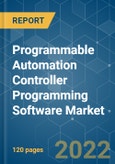The Programmable Automation Controller (PAC) programming software market is expected to register a CAGR of 15% during the forecast period (2021 - 2026). With the rapid increase in demand for the automated manufacturing process in various verticals, such as manufacturing, automotive, and chemical, the market is expected to witness high growth.
Key Highlights
- PACs are the combined features of traditional automation technologies, such as distributed control systems (DCSs), programmable logic controllers (PLCs), personal computers (PCs), and remote terminal units (RTUs).
- The rapidly rising need for automation and with the increasing technological advancements in the field of sensors, machine size (emergence of smaller automated machines), software, the market is witnessing high growth.
- The usage of PAC’s will shift firms’ focus on open communication standards and software integration with less focus on the hardware. As users focus more on the total system performance rather than just the hardware selection, PAC’s will become more demanding by customers who are not satisfied by traditional PLC’s.
- Moreover, the rise in industrialization and increase in the number of manufacturing units across several developed as well as developing regions including North America, Europe, and Asia-Pacific will further boost the market studied.
Key Market Trends
Rise in Automation to Augment Market Growth
- The advent of automation in various industries has facilitated the control over various operational aspects of industries, without any significant intervention from operators, using various control devices and software.
- These automation devices combine the advantages of a PLC-style traditional machinery or process control system, with the flexible type configuration and integration advantages of PC-based system, using a PAC (programmable automation controller), due to the various advantages of PAC programming software, the market is expected to grow further.
- Developing economies, such as China, India, etc., are primarily driving the growth of the automation industry. Emerging economies are also investing heavily in the development of several industries and the adoption of automation.
- With the increasing supply of industrial robots across the world, it is evident that automation is rapidly increasing in various manufacturing sectors, which is boosting demand in the market studied.
Asia-Pacific to Witness High Growth
- Asia-Pacific region is witnessing high growth, benefiting from recent policy changes, investments in automation, and availability of commodities at lower prices.
- The inception of many power generation projects after the global recession and the initiation of large-scale Greenfield projects in the region have driven the demand for PAC programming software market.
- China is considered as the manufacturing hub of the world, with manufacturing facilities of domestic as well as international players set up in the country. As the labor cost is rising in the country, China is rapidly transforming from a medium to a high-tech manufacturing hub, which is expected to further propel the market growth
- India is launching initiatives like ‘Make in India’ to place the country on the world map as a manufacturing hub and to gain global recognition. The Indian Brand Equity Foundation has reported that India is expected to become the fifth-largest manufacturing country in the world by the end of 2020.
Competitive Landscape
The PAC programming software market is highly competitive with the presence of many big and small players. The market appears to be moderately concentrated and the key strategies adopted by the major players are product innovation and mergers and acquisition. Some of the key players in the market are Schneider Electric, Rockwell Automation, Siemens AG, among others.
- February 2018: Honeywell international collaborated with Equate Petrochemical Company, a global producer of petrochemicals. Both the companies signed an MoU, for the development of technologies that will support operations at Equate Petrochemical.
Additional Benefits:
- The market estimate (ME) sheet in Excel format
- 3 months of analyst support
This product will be delivered within 2 business days.
Table of Contents
Methodology

LOADING...








